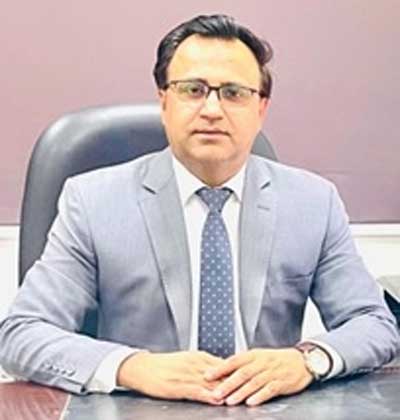Technology is advancing in every area that will contribute to education, and education is evolving at a rate that has never been witnessed before. This phenomenon is a well-known aspect of contemporary civilization. The way institutions operate will be completely transformed by new disciplines in higher education, perhaps the most revolutionary one – the Internet of Things. Using IoT is a need not an option, for Pakistani higher education IoT is not a novel subject but still there is a lot to achieve.
The term “Internet of Things,” abbreviated as (IoT), is a recent marketing term that describes a network of real-world objects, including appliances, cars, and other things having electronics, software, and sensors implanted in them. Furthermore, this interconnection facilitates efficient and tailored communication, which quickens the decision-making process in real time across several domains. In a similar vein, universities everywhere are utilizing IoT to improve their academic offerings and streamline processes. With improved resource utilization, including interactive teaching techniques, smart gadgets, and IoT-based classroom systems, even pupils might learn in an adaptive way. Smart board technology and IoT-enabled learning platforms are two ways this might be accomplished. With these, students can access educational resources instantly.
The Internet of Things (IoT) is fundamentally transforming educational institutions by enhancing operational efficiency, security, and the overall learning environment. Through IoT technology, schools and universities can implement smart lighting systems that automatically adjust based on classroom usage, which not only conserves energy but also creates a more conducive atmosphere for learning.
Additionally, advanced security systems monitor student movement and campus activity in real time, ensuring safety and enabling quick responses to potential threats. IoT also facilitates improved facilities management by providing actionable data on maintenance needs, helping institutions optimize resource allocation and reduce costs. Furthermore, IoT enables personalized learning experiences through adaptive technologies that cater to individual student needs, enhancing engagement and academic performance. Overall, the integration of IoT creates smarter, more connected educational environments that promote sustainability, improve safety, and support innovative teaching methods, preparing students for success in an increasingly digital world.
Pakistani universities also follow the trend of digital transformation but have a long way to go in terms of adopting IoT. With the rise of the population and demands for quality education at an all-time high, Pakistani universities need to step-up their game regarding the implementation of IoT. The points under listed are some of the reasons; Why IoT is important for higher education in Pakistan.
One of the grand opportunities with IoT is personalization in education. Schools can provide a tailored learning pathway to each student as one would to a recipe-the smart devices, armed with the bite-sized-data insights. This can especially work well in a diversified country like Pakistan where differences in all types of students-background wise-are needed to be engaged with at various levels. This aspect is best exhibited through IoT-enabled platforms that would provide instant feedback for assessment based on how the student is progressing in any one subject area. For such a student, movements go undetected in an effort to improve the learning materials presented.
The Internet of Things (IoT) is transforming the global economy, with over 26 billion people, systems, and objects currently connected, and projections estimating 50 billion devices by 2030. By 2029, the IoT market is expected to grow to $2.46 trillion, with the majority (80%) of economic activity driven by IoT, particularly in industrial sectors, while the remaining 20% is attributed to the Internet of People (IoP).
Pakistani universities often face challenges due to the inadequate use of resources. With the integration of IoT, these institutions can optimize resource utilization. For instance, IoT-based smart energy management systems can reduce energy consumption by up to 30% by adjusting lighting and temperature according to occupancy. Additionally, IoT-enabled inventory management systems can efficiently track resources such as books and lab equipment, and monitor faculty presence, improving overall efficiency and resource management by up to 20%.
The safety and protection of students are increasingly becoming a global concern for educational institutions. IoT-enabled security solutions, such as connected CCTV cameras, biometric access controls, and real-time student tracking, can enhance campus security by up to 40%. These systems not only improve student safety but also provide peace of mind to parents and guardians by offering real-time updates and monitoring.
As the education sector is getting more data-driven, with the use of IoT devices, universities can collect and analyze data on student behavior, resource utilization, and academic performance. For example, data collected from IoT sensors in classrooms will be able to provide insights into attendance, monitor student engagement, and give real-time feedback to professors so they may need to adjust their teaching methodologies.
IoT offers vast opportunities for research in fields like engineering, computer science, and environmental studies. By collaborating with industries to develop IoT-based solutions for real-world issues such as smart agriculture, energy efficiency, and urban planning, universities can drive innovation. Integrating IoT into Pakistani universities’ research programs could lead to a 25-30% increase in innovation output, attracting international collaborations and funding, and positioning these institutions as global leaders in technological advancements.
Though this offers much potential for their inclusion into Pakistani universities, integrating IoT comes with its own set of challenges. The most significant challenge is the infrastructure. In most areas, especially rural ones, there is a shortage of basic digital infrastructure for universities to support the IoT. Skilled professionals who can maintain and manage IoT systems are also deficient.
One major challenge lays in data privacy and security issues. In the IoT, devices collect tremendous volumes of data; hence, securing all this collected information on the part of Pakistani universities would prove to be a problem due to less robust cyber security measures for safeguarding both student and institutional data. In Pakistan, IoT is being integrated across various sectors, including agriculture, healthcare, energy, and smart cities, with telecom providers advancing IoT services through 4G and 5G networks, enabling innovative solutions like smart grids, precision farming, and automated industrial systems.
Well, a defined IoT strategy for Pakistani universities will solve all of these problems. Investment in digital infrastructure, faculty training and partnerships with industry leaders regarding IoT are some of the issues to be addressed in the strategy. Funding through the government also encourages the usage of IoT in academic institutions.
Moreover, IoT-related curricula should be developed in universities with these requirements such that students may be trained for the job market that would be driven by IoT. The courses of IoT, AI, and data analytics should also be included in the university programs, and those coming from such programs should be better equipped than the futures cape workforce.
Internet of Things is an innovative move for education, and a change in technological revolution will require the preparation of Pakistani universities; through IoT integration, it could enrich the learning experience, improve operating efficiency, and position universities better in innovation. The future of higher education in Pakistan is poised in the effectiveness of the universities in adopting and adapting to IoT and maintaining competitive positioning in the global educational landscape.





